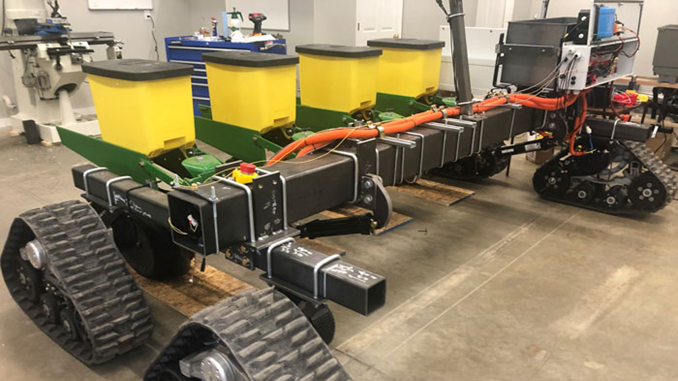Ag Informer – Testing on Autonomous Planter Underway

 |
|---|
| Salin 247’s 2022 prototype autonomous electric-drive unit, prepared for planting, features the ability to switch hit between planting, spraying and side-dressing with a lighter footprint and improved cost-effectiveness over traditional pull-behind equipment. |
by Dan Crummett, Farm Equipment magazine
Iowa start-up Salin 247 field testing autonomous electric drive unit for planting in Iowa and Tennessee fields. Prototype machine also offers post-emergence capabilities in spraying and side-dressing.
With a lifetime of farming experience and degrees in agronomy and economics, Dave Krog says he’s trying to whittle variable and fixed costs from today’s equipment outlays with an electric, autonomous drive unit aimed squarely at the 24-row planter.
“Our goal is to make this kind of solution less expensive than today’s technology,” Krog says. “By eliminating the tractor and the heavy sprayer, we can leverage our running gear and chassis over many operations.”
Doing business as Salin 247, in Ames, Iowa, Krog and his engineer son ran their first two-track-drive prototype robot in Iowa in 2021, and plan to have the second, upgraded version of the machine planting soybeans and corn in Iowa and Tennessee this spring.
The 2022 test version consists of 4 individually-powered electrically-driven track units mounted on the corners of a rectangular steel tool-bar frame. The drive unit carries a 48 Volt, 100-amp (10 kWh) lithium iron-phosphate battery pack along with RTK GPS navigation equipment and 2020 Precision Planting equipment and software. The machine uses cameras and computer vision for safety and obstacle detection. Plus, the Krogs are also testing on-board radar technology.
The 4-row prototype is designed to plant at 5.5 mph, and carry spray and side-dress capabilities up to 10 mph.
“We could put speed tubes on for planting, but we want to prove our design at slower speeds first,” Krog explains. “For post-emergence work our unit is slower than the big rigs, but we foresee a time when several of our drive units could be doing the job of the larger machines at less cost – and because they are lighter, and equipped with machine vision, they can get in the field quicker after a rain and work in all light conditions.”
to read the entire report click here.




